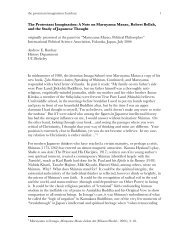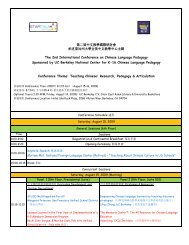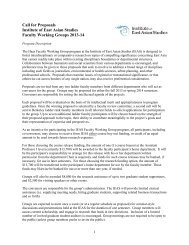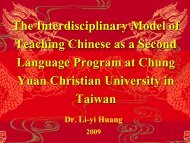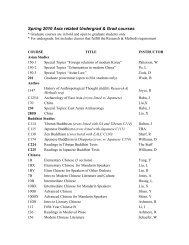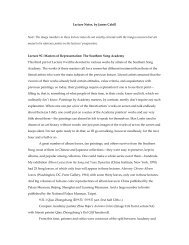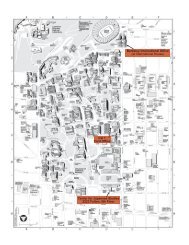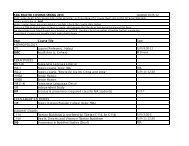Third Edition Spring 2013 - Institute of East Asian Studies, UC ...
Third Edition Spring 2013 - Institute of East Asian Studies, UC ...
Third Edition Spring 2013 - Institute of East Asian Studies, UC ...
Create successful ePaper yourself
Turn your PDF publications into a flip-book with our unique Google optimized e-Paper software.
and its people through many historical ups and downs.” 15 Amongthe numerous images, the book contains famous photos taken byWestern photojournalists. The Ministry <strong>of</strong> Culture has taken theseimages and has explicitly re-captioned them in order to promotethe Vietnamese government’s constructed cultural memory <strong>of</strong> thewar. 16Walter Cronkite wrote in LIFE, “correspondents and photographersin Vietnam could, accompany troops to wherever theycould hitch a ride, and there was no censorship . . . That system—or lack <strong>of</strong> one—kept the American public well informed <strong>of</strong> our soldiers’problems, their setbacks and their heroism.” Capturing imagesthat highlighted the factors Cronkite mentioned was a maingoal for American photojournalists. An example <strong>of</strong> this type <strong>of</strong>powerful imagery that came out <strong>of</strong> the Vietnam War is the photo“Reaching Out” taken by Larry Burrows. This iconic photo has beentaken by the Ministry <strong>of</strong> Culture and re-captioned with the message“US troops died at the battlefields in Central Vietnam”. Thiscaption demonstrates a stark contrast with the interpretation <strong>of</strong>the war <strong>of</strong>fered in the original LIFE caption that reads “a woundedMarine desperately trying to comfort a stricken comrade after afierce firefight.”Purposes <strong>of</strong> Constructed Cultural MemoryThe combination <strong>of</strong> the circulation <strong>of</strong> chosen images and their captioningby the Vietnamese government serves as a visual insightinto the strategies and workings <strong>of</strong> constructing the cultural memory<strong>of</strong> a people’s war. 17 Through a strategy <strong>of</strong> publicizing imagesthat capture citizens <strong>of</strong> different ages and genders participatingin the war effort, the government helped legitimize its claims towaging a “people’s war.” After the war, the re-captioning <strong>of</strong> famous15 Lê, Phức, and Thành, Chi. Ảnh Việt Nam Thế Kỷ XX = Vietnamese Photographyin the 20th Century = La Photographie Du Vietnam Au 20e Siècle. Hà Nội: Nhà Xuất BảnVăn Hoá Thông Tin, 2002.16 Ibid17 Schwenkel, Christina. Exhibiting War, Reconciling Pasts: Photographic Representationand Transnational Commemoration in Contemporary Vietnam. Journal <strong>of</strong>Vietnamese <strong>Studies</strong> 3.1, 2008.photos helped the government hold on to this inherited right topower. The constructed historical narrative promotes the idea thatthe government in the past had fought and won the “people’s war,”and that the current government now continues to uphold its pastgoals and aspirations. The stake in maintaining this cultural memory<strong>of</strong> a “glorious war” lies in the power the memory has in legitimizingthe government. Legitimacy is the main concern for thecommunist government <strong>of</strong> Vietnam.The government’s concern with legitimacy manifests itselfin the severe curtailment <strong>of</strong> civil and political rights in the hope<strong>of</strong> maintaining the one-party system that is seen as essential forthe unity and prosperity <strong>of</strong> the country. 18 These limitations stemfrom general anxieties about state independence, territorial integrity,and social cohesion. 19 Vietnam extends this curtailment <strong>of</strong> civiland political rights to photographers and their photographs. Thetension between government anxieties and the photographer’sartistic expressions are encapsulated in the significant changes inculture production following the Doi Moi reform periods.The Doi Moi Reforms and Culture ProductionAfter political reunification in 1975 the Communist leadership<strong>of</strong> Vietnam decided to pursue a second five year plan whichaimed to integrate the North and South Vietnam economies as rapidlyas possible with the socialist transformation <strong>of</strong> Vietnamese societybeing the ultimate goal. 20 The term ‘‘socialism’’ held a particularmeaning in Soviet-type economies, basically consisting <strong>of</strong> (i)allocation <strong>of</strong> resources through central planning and elimination<strong>of</strong> markets for goods and labor; (ii) ownership <strong>of</strong> all major means<strong>of</strong> production by the state, representing the whole society, and theelimination <strong>of</strong> private enterprise; and (iii) distribution <strong>of</strong> income18 Logan, William. Protecting the Tay Nguyen gongs: Conflicting rights in Vietnam’scentral plateau. Cultural Diversity, Heritage and Human Rights, 2010.19 Ibid20 Duiker, William J. “Vietnam: the challenge <strong>of</strong> reform.” Current History 88, no.537 (1989): 177-178.33 Mark Portillo Constructing “Culture” 34




